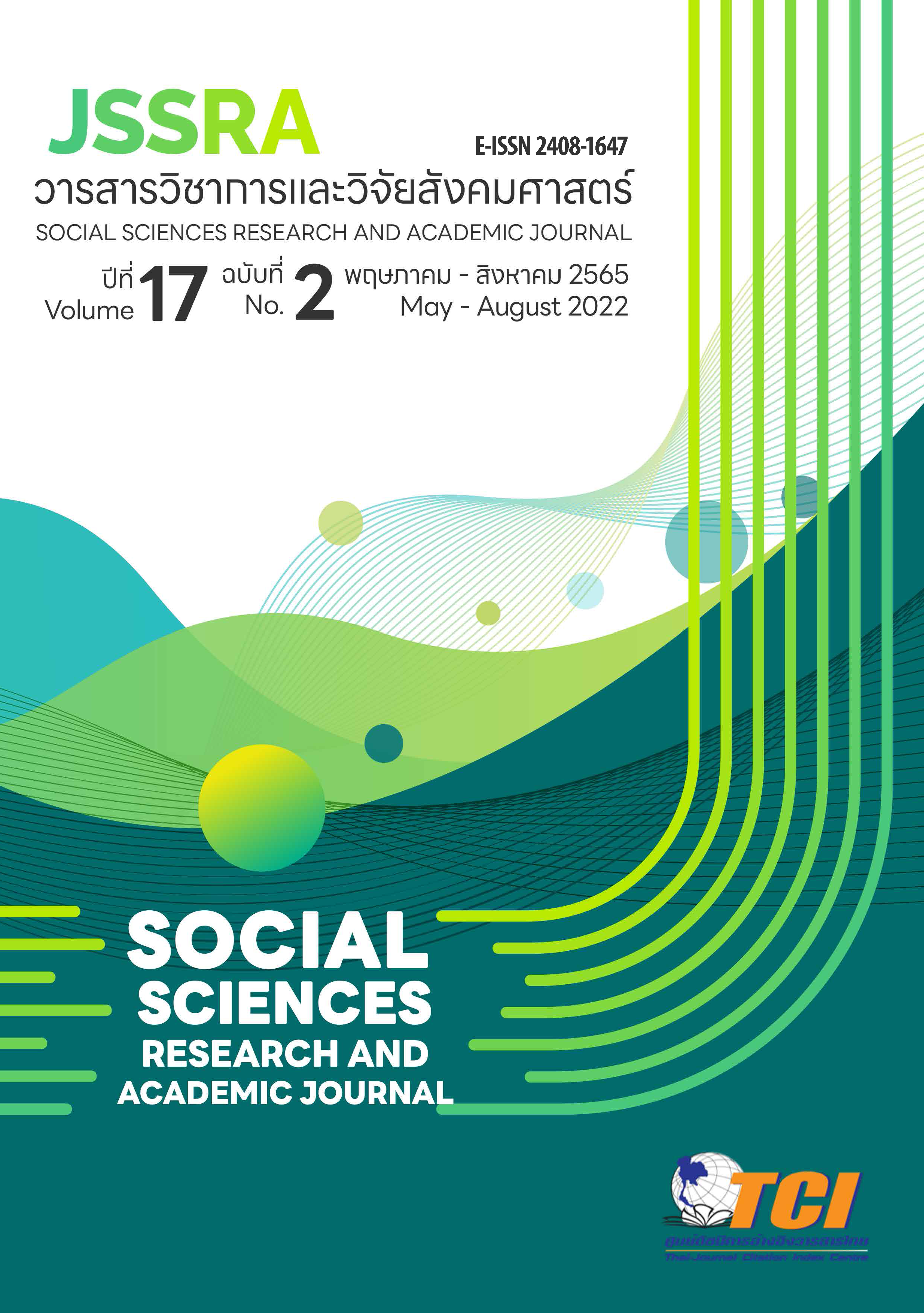การพัฒนาชุดฝึกอบรมครูเพื่อพัฒนาหลักสูตรภัยพิบัติท้องถิ่นแผ่นดินไหวที่เหมาะสม ในสถานการณ์การแพร่ระบาดของโควิด-19 The Development of Teachers’ Training Package to Develop a Local Earthquake Disaster Curriculum with Appropriation to the Pandemic of COVID-19
Main Article Content
บทคัดย่อ
การวิจัยครั้งนี้มีวัตถุประสงค์เพื่อ 1) ศึกษาแนวทางการฝึกอบรมครูทั้งโรงเรียนเพื่อพัฒนาหลักสูตรภัยพิบัติท้องถิ่นแผ่นดินไหวในระหว่างเผชิญการแพร่ระบาดของโควิด-19 2) สร้างและตรวจสอบคุณภาพชุดฝึกอบรมครูเพื่อพัฒนาหลักสูตรภัยพิบัติท้องถิ่นแผ่นดินไหว 3) ศึกษาประสิทธิผลการฝึกอบรมครูเพื่อพัฒนาหลักสูตรฯ แบบผสมผสานด้วยแพลตฟอร์มออนไลน์และเครือข่ายในพื้นที่ กลุ่มเป้าหมาย ได้แก่ ครูโรงเรียนในพื้นที่เสี่ยงภัยแผ่นดินไหว จังหวัดเชียงราย ปีการศึกษา 2563 จำนวน 3 โรงเรียน รวมทั้งสิ้น 38 คน ดำเนินการวิจัยด้วยกระบวนการวิจัยและพัฒนา 3 ขั้นตอน ขั้นตอนที่ 1 ศึกษากระบวนการฝึกอบรมโดยการสัมภาษณ์เชิงลึกผู้เชี่ยวชาญ ขั้นตอนที่ 2 ฝึกอบรมครูเพื่อพัฒนาหลักสูตรด้วยแพลตฟอร์มออนไลน์ ขั้นตอนที่ 3 พัฒนาครูโดยใช้เครือข่ายในพื้นที่ ซึ่งเป็นครูพี่เลี้ยงที่โรงเรียนประสบภัยแผ่นดินไหวเหมือนกัน และมีผลงานการปฏิบัติที่ดีช่วยเป็นโค้ชและพี่เลี้ยงหนุนเสริมพลัง เครื่องมือ ที่ใช้ในการวิจัย ได้แก่ แบบสัมภาษณ์กึ่งโครงสร้าง ชุดฝึกอบรมครูพัฒนาหลักสูตร และแบบประเมินความพึงพอใจ วิเคราะห์ข้อมูลโดยใช้ค่าเฉลี่ย ส่วนเบี่ยงเบนมาตรฐาน และการวิเคราะห์เนื้อหา ผลการวิจัยพบว่า 1) กระบวนการฝึกอบรมครูทั้งโรงเรียนเพื่อพัฒนาหลักสูตรภัยพิบัติท้องถิ่นแผ่นดินไหวเมื่อเผชิญการแพร่ระบาดจากของโควิด-19 ที่เหมาะสมกับการวิจัยครั้งนี้เป็นแบบผสมผสานด้วยแพลตฟอร์มออนไลน์ทั้งนี้ใช้โปรแกรม Microsoft Teams และใช้เครือข่ายในพื้นที่ที่เป็นครูพี่เลี้ยงจากโรงเรียนต้นแบบด้านหลักสูตรแผ่นดินไหว จังหวัดเชียงราย ซึ่งเคยร่วมโครงการกับคณะนักวิจัย มีเจตนารมณ์ร่วมกัน และมีความสัมพันธ์เชิงบวก 2) ชุดฝึกอบรมครูเพื่อพัฒนาหลักสูตรภัยพิบัติท้องถิ่นแผ่นดินไหวมีจำนวน 5 หน่วย คือ 1) การสร้างแรงบันดาลใจพัฒนาหลักสูตร 2) การบูรณาการภัยพิบัติสู่ชั้นเรียน 3) การพัฒนาหลักสูตรภัยพิบัติท้องถิ่นแผ่นดินไหว 4) การนำหลักสูตภัยพิบัติท้องถิ่นแผ่นดินไหวไปใช้ และ 5) การประเมินผลการใช้หลักสูตรภัยพิบัติท้องถิ่นแผ่นดินไหว มีผลการประเมินความเหมาะสมอยู่ในระดับมากที่สุด 3) ครูมีความพึงพอใจต่อการฝึกอบรมพัฒนาหลักสูตรภัยพิบัติท้องถิ่นแผ่นดินไหว ภาพรวมอยู่ในระดับมาก การฝึกอบรมครูเพื่อพัฒนาหลักสูตรแบบผสมผสานสามารถใช้แก้ปัญหาการพัฒนาครูเมื่อเผชิญภาวะวิกฤติจากการแพร่ระบาดของโควิด-19 ทำให้ครูเกิดการเรียนรู้ และมีความสามารถในการพัฒนาหลักสูตรเทียบเท่ากับรูปแบบปกติ มีข้อดีคือ ประเด็นเรื่องเวลา ค่าใช้จ่าย และความสะดวกสบาย รวมถึงครูรู้สึกมีเพื่อนร่วมทาง เกิดการประสานพลังกันในการพัฒนาหลักสูตรกับครู พี่เลี้ยงจากโรงเรียนในพื้นที่ ทำให้ได้หลักสูตรที่สอดคล้องกับบริบท และนำไปใช้ได้จริง
Article Details
เอกสารอ้างอิง
คุณาพร วรรณศิลป์ สมปอง ศรีกัลยา และภูษิต บุญทองเถิง. (2554). การพัฒนาหลักสูตรฝึกอบรมครูด้วยรูปแบบผสมผสาน เรื่อง การทำวิจัยในชั้นเรียน. วารสารศึกษาศาสตร์ มหาวิทยาลัยมหาสารคาม, 13(3), 25-40.
จักรกฤษณ์ จันทะคุณ. (2558). ภัยพิบัติศึกษา: แนวทางการจัดกิจกรรมการเรียนรู้เพื่อเตรียมความพร้อมรับมือภัยพิบัติ (ตอนที่ 1). วารสารศึกษาศาสตร์ มหาวิทยาลัยนเรศวร, 17(4), 188-201.
จักรกฤษณ์ จันทะคุณ. (2562). การพัฒนาหลักสูตรภัยพิบัติท้องถิ่นแผ่นดินไหว สำหรับโรงเรียนในพื้นที่เสี่ยงภัยแผ่นดินไหว ด้วยการจัดการความรู้. (รายงานวิจัยฉบับสมบูรณ์) สนับสนุนโดยสำนักงานกองทุนสนับสนุนการวิจัย และมหาวิทยาลัยพะเยา.
เจือจันทร์ จงสถิตอยู่ และอรุณศรี จิตต์แจ้ง. (2556). พลังเครือข่ายในพื้นที่. กรุงเทพ ฯ: สำนักงานกองทุนสนับสนุนการวิจัย.
นันทิยา หุตานุวัฒน์ และณรงค์ หุตานุวัฒน์. (2546). การพัฒนาองค์กรชุมชน. กรุงเทพฯ: สถาบันพัฒนาองค์กรชุมชน (องค์การมหาชน).
พัชนี กุลฑานันท์. (2554). การพัฒนารูปแบบการฝึกอบรมครูด้วยรูปแบบแบบผสมผสานในการทําวิจัยในชั้นเรียน. มหาวิทยาลัยราชภัฏมหาสารคาม, 5(2), 97-115.
ณัฐหทัย สร้างสุข. (2559). การพัฒนารูปแบบการฝึกอบรมแบบผสมผสานตามแนวคิดโซสิโอคอนสตรัคติวิสต์เพื่อเพิ่มพูนสมรรถนะการพัฒนาตนเองของครู. สืบค้นเมื่อวันที่ 14 กันยายน 2563, จาก http://www.thai-explore.net/search_detail/result/5215
วรกิต วัดเข้าหลาม และไมตรี อินทร์ประสิทธิ์. (2555). การพัฒนาเครือข่ายการพัฒนาวิชาชีพครูคณิตศาสตร์ ระหว่างประเทศในเขตอนุภูมิภาคลุ่มน้ำโขงโดยใช้การประชุมผ่านเครือข่าย. สนับสนุนทุนวิจัยประเภทอุดหนุนทั่วไป, ขอนแก่น. มหาวิทยาลัยขอนแก่น.
วารีรัตน์ แก้วอุไร, จักรกฤษ กลิ่นเอี่ยม และประทีป คงเจริญ. (2562). การพัฒนาเครือข่ายครูในการพัฒนากิจกรรมการเรียนรู้ที่มุ่งส่งเสริมผู้เรียนด้านทักษะการสร้างสรรค์และนวัตกรรม. วารสารวิชาการเครือข่ายบัณฑิตศึกษามหาวิทยาลัยราชภัฏภาคเหนือ, 9(2), 77-92.
สุพร รัตนนาคินทร์. (2550). รายงานการประชุมเชิงปฏิบัติการในโครงการความร่วมมือทางวิชาการจาก JICA. สืบค้นเมื่อ 21 เมษายน 2554, จาก http://www.disaster.go.th/dpm/index.php?option=com.
Billings, D. & Kowaiski, K. (2006). Preparing for natural and man-made disasters. The Journal of Continuing Education in Nursing, 37(2), 56-57, DOI: 10.3928/00220124-20060201-03
Consortium for Disaster Education Indonesia. (2011. A Framework of School-Based Disaster Preparedness. สืบค้นเมื่อ 10 ธันวาคม 2557, จาก http://www.preventionweb.net/.../26013_26008aframeworkofschool.
Dufty, N. (2018). A new approach to disaster education. Retrieved March 4, 2019, from https://www.researchgate.net/publication/329105392_A_new_approach_to_disaster_education
Eshtehardi, R. (2014). Pro-ELT; A Teacher Training Blended Approach. Advances in Language and Literary Studies, 5(5), 106-110.
Fielding, M. et al. (2005). Factors influencing the transfer of good practice. Research report. Retrieved May 5, 2020, from https://www.dera.ioe.ac.uk/21001/1/RR615.pdf.
Katz, S., Earl, L., Ben, J. S., Elgie, S., Foster, L., Halbert, J., & Kaser, L. (2008). Learning networks of schools: The key enablers of successful knowledge communities. McGill Journal of Education, 43(2), 111. DOI:10.7202/019578ar
Lyst, C. (2020). Coronavirus: What is a blended model of learning. Retrieved May 22, 2020, from https://www.bbc.com/news/uk-scotland-524171.
Preston, J. (2012). Disaster Education ‘Race’, Equity and Pedagogy. Retrieved January 14, 2015, from https://www.sensepublishers.com.
Shahadi, N. & Maru, S. (2005). Life has change teachers’ guide. Retrieved May 24, 2011, from
http://www.unicef.org/.../Life_has_changed_Teachers_guide.
Thijs, A., & Van den Akker, J. (2009). Curriculum in development. Enschede, The Netherlands: SLO.
Thom, K. (2003). Blended learning: How to integrate online and traditional learning. London: Kogan.
Yustina, Syafii & Vebrianto. (2020). The effects of blended learning and project-based-learning on pre- service biology teachers’ creative thinking through online learning in the covid-19 pandemic. Journal Pendidikan IPA Indonesia. Retrieved May 10, 2020, from http://www.journal.unnes.ac.id/index.php/jpii DOI: 10.15294/jpii.v9i3.24706
Zubenko, W.N. & Capozzoli,J. A. (Eds.). (2002). Children and disaster and disasters: A practical guide to healing and recovery. New York: University Press.


